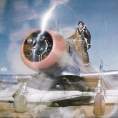Some. Depends on the model. Look at the TCDS under "Certification Basis" and you note all models up to the G are pure CAR 3, in which burn certs are not required. Starting with the J model there is some Part 23 basis to the TCDS which activates burn certification requirements. The OP is an R model. They also have to comply with Part 36 starting with the J model.
"\
Model M20R CAR 3 effective November 1, 1949, as amended to May 18, 1954, paragraph 3.74 as amended to August 25, 1955; paragraphs 3.109, 3.112, 3.115, 3.118, 3.120, and 34.441 of CAR 3 effective May 15, 1956; as amended to October 1, 1959.
In lieu of corresponding CAR 3 paragraphs, where applicable - FAR 23, effective February 1, 1965; paragraph 23.29 as amended to March 1, 1978, paragraph 23.33, as amended to September 14, 1969; paragraphs 23.901 through 23.953, 23.955 through 23.963, 23.967 through 23.1063, as amended to September 14, 1969; paragraphs 23.1091 through 23.1105, as amended to February 1, 1977; paragraphs 23.1121 through 23.1193, 23.1351 through 23.1399 as amended to September 14, 1969, paragraphs 23.1401 as amended to August 11, 1971; paragraphs 23.1441 through 23.1449 as amended to June 17, 1970, paragraph 23.1521 as amended to December 1, 1978, paragraph 23.1525; paragraph 23.1527, as amended to September 14, 1969; paragraphs 23.1545, 23.1549, 23.1553 as amended to December 1, 1978, paragraph 23.1557, as amended to December 20, 1973; paragraph 23.1559 as amended to March 1, 1978; paragraph 23.1563 as amended to September 14, 1969; paragraph 23.1583 as amended to December 1, 1978, FAR 36 effective September 20, 1976, as amended to December 22, 1988.

